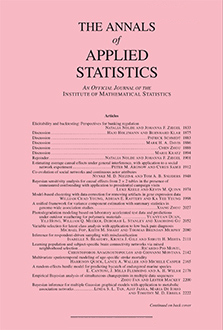Abstract
The recent curation of large-scale databases with 3D surface scans of shapes has motivated the development of tools that better detect global patterns in morphological variation. Studies, which focus on identifying differences between shapes, have been limited to simple pairwise comparisons and rely on prespecified landmarks (that are often known). We present SINATRA, the first statistical pipeline for analyzing collections of shapes without requiring any correspondences. Our novel algorithm takes in two classes of shapes and highlights the physical features that best describe the variation between them. We use a rigorous simulation framework to assess our approach. Lastly, as a case study we use SINATRA to analyze mandibular molars from four different suborders of primates and demonstrate its ability recover known morphometric variation across phylogenies.
Funding Statement
This research was partly supported by grants P20GM109035 (COBRE Center for Computational Biology of Human Disease; PI Rand) and P20GM103645 (COBRE Center for Central Nervous; PI Sanes) from the NIH NIGMS, 2U10CA180794-06 from the NIH NCI and the Dana Farber Cancer Institute (PIs Gray and Gatsonis), an Alfred P. Sloan Research Fellowship and a David & Lucile Packard Fellowship for Science and Engineering awarded to LC. A majority of this research was conducted using computational resources and services at the Center for Computation and Visualization (CCV), Brown University. SM would like to acknowledge partial funding from HFSP RGP005, NSF DMS 17-13012, NSF BCS 1552848, NSF DBI 1661386, NSF IIS 15-46331, NSF DMS 16-13261 as well as high-performance computing partially supported by grant 2016-IDG-1013 from the North Carolina Biotechnology Center. Lastly, TG was supported by NSF Grant No. DMS-1439786 while in residence at the Institute for Computational and Experimental Research in Mathematics (ICERM) in Providence, RI, during the Computer Vision Semester Program in Spring 2019 and partially by NSF DMS-1854831 afterward. Any opinions, findings, and conclusions or recommendations expressed in this material are those of the author(s) and do not necessarily reflect the views of any of the funders.
Acknowledgments
We would like to thank the Editor, Associate Editor and two anonymous referees for their constructive comments. We would also like to thank Ani Eloyan, Anthea Monod, Jenny Tung, Katharine Turner and Christine Wall for helpful conversations and suggestions. We are also very appreciative to Ruqi Huang and Maks Ovsjanikov for sharing their MATLAB implementation of limit shapes.
Citation
Bruce Wang. Timothy Sudijono. Henry Kirveslahti. Tingran Gao. Douglas M. Boyer. Sayan Mukherjee. Lorin Crawford. "A statistical pipeline for identifying physical features that differentiate classes of 3D shapes." Ann. Appl. Stat. 15 (2) 638 - 661, June 2021. https://doi.org/10.1214/20-AOAS1430
Information





